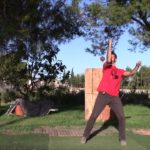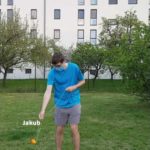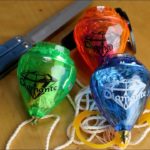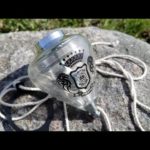Here I explore the influence of mass distribution and tip radius of curvature on spin-down behavior in a group of small LEGO finger tops specifically designed for that purpose.
The top behaviors seen here are intrinsic to the tops and are little affected by my twirling technique. These improbable-looking tops are “gyrophonic” in that their spin-downs are generally divided into behaviorally distinct phases or modes, each with its own characteristic sound on a hard surface.
After watching a few of the tops go through their modes, you can close your eyes and still know exactly what they’re doing! And they’re “sidewinders” in that they spend much of their time at tilt angles well above 60° and finish by spinning rapidly on their sides — i.e., at a 90° tilt. Release speeds here are generally in the 5,500-6,500 RPM range, but some may go as high as 7,600 RPM.
The same behaviors are still present at motorized release speeds of up to 9,600 RPM (not shown), but spin times are longer, and any sleeping right after release may last a little longer.
Each top starts out spinning about its own symmetry axis, which coincides with its central axle. Sooner or later, precession of the axle about the vertical appears. In most cases, precession rate and axle tilt increase steadily as the spin rate continues to decay.
The top’s center of mass (CM) descends accordingly. Wobble occasionally adds a bucking motion to the CM’s descent but is otherwise absent. The opening title reflects the fact that in nearly every case, precession is both the most conspicuous of these motions and the one most conspicuously affected by experimental changes. The very first top, shown only as a reminder of the way tops usually behave, has a rotor made of 3×3 dishes strung along a 3 mm bar also serving as stem and tip. The very last top was thrown in just for kicks.
The tops in between are our “test tops”. They have rotors made of various combinations of (i) 3×3 pulley wheels, (ii) 3×3 Technic disks, and occasionally (iii) Technic balls with through-holes. These “rotor elements” are strung along an axle also serving as stem and tip mount.
A few of the test tops have “fine tips” with the same radius of curvature (1.5 mm) as the very first top, but most have “ball tips” with a 5 mm radius of curvature. As you can see, tip radius of curvature has a profound effect on top behavior during spin-down. For one thing, tops with ball tips have much stronger self-righting tendencies than those with fine tips.
The video comes in 2 segments separated by a transition. Each new test top in a given segment generally represents a single change from the top before — e.g., a different tip, a new rotor position, or the addition or removal of some rotor elements. Some tops appear more than once. In each case, notice how rotor and tip changes affect precession, CM descent, and wobble. Notice also that in precessing tops, the vertical precession axis passes through the CM rather than the tip, and that the tip orbits around the point where this axis intersects the supporting surface (glass platter).
Top parameters manipulable with rotor changes:
Total mass
CM height
Transverse moment of inertia about the tip (TMI)
Axial moment of inertia (AMI) Associated changes in air resistance and tip friction are probably negligible.
Things to keep in mind as you watch:
Every added rotor element draws the top’s CM toward its location along the axle.
When a rotor simply slides up its axle en bloc, CM height and TMI both increase per the parallel axis theorem, but AMI doesn’t change.
Due to the way these tops are constructed, when AMI increases — e.g., by adding wheels or disks, or by adding tires to existing wheels — CM height and TMI usually change as well, though each at its own rate, and not necessarily in the same direction. The opposite also holds.
See also:
Same footage processed in outline (edge-detection effect) to emphasize behavior @ https://www.youtube.com/watch?v=y-Ti8…
Photos and discussion coming soon @ http://www.moc-pages.com/home.php/99234
Similar fluorescent tops under blacklight @ https://www.youtube.com/watch?v=a2ckz…
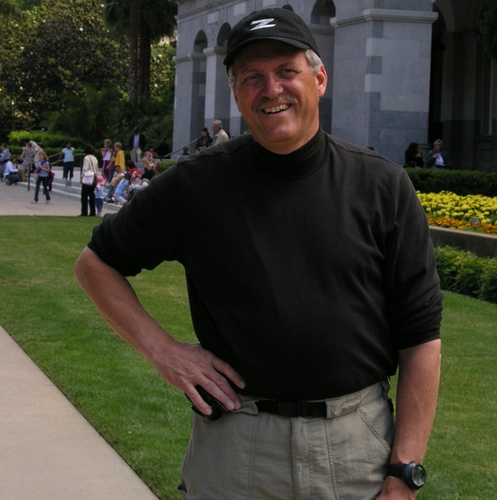
Jeremy McCreary
Lego spintop crafter
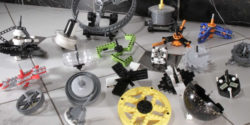
Most of the videos here are extracted from my MOCs pages there and are working gizmos born of a fascination with gadgets and the science and engineering behind them. Technical LEGO® — my term for the fusion of LEGO® with STEM (science, technology, and math) subject matter — brings out my inner inventor/designer/engineer/toymaker like no other medium.
My work owes a great deal to the folks on my list of favorite builders. Their imagination and ingenuity never cease to amaze.

